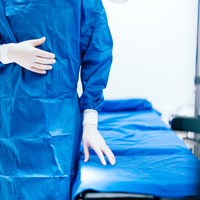Dangers of Gastric Balloons
August 7, 2018 For many people in this country, losing weight is a difficult task. When regular exercise and diet modifications have been difficult to achieve, many people turn to their healthcare provider for help. There are several procedures that can help with weight loss, including gastric bypass surgery. Other, less invasive procedures are also available, including gastric balloons that are meant to make the patient feel full. Unfortunately, there have been 12 reported fatalities associated with the intragastric balloon since 2016.
For many people in this country, losing weight is a difficult task. When regular exercise and diet modifications have been difficult to achieve, many people turn to their healthcare provider for help. There are several procedures that can help with weight loss, including gastric bypass surgery. Other, less invasive procedures are also available, including gastric balloons that are meant to make the patient feel full. Unfortunately, there have been 12 reported fatalities associated with the intragastric balloon since 2016.
According to the Food and Drug Administration (FDA), seven out of the 12 patients who were fatally injured were from the United States. As a result, the FDA approved new warning labels for two balloon products that were used in the procedures. Gastric balloons can help reduce a person’s appetite, as well as the amount of food consumed by reducing the amount of space available in the stomach by 50 percent. A deflated balloon is sent down a patient’s throat where it travels to the stomach. They are then inflated with a saline solution, or a gas, depending on the type of procedure, which fills the balloons.
To avoid side effects, the balloons are removed from the stomach after six months. After the balloon has been removed, patients receive an additional six months of diet and lifestyle counseling to help maintain weight loss and prevent the patient from slipping back into unhealthy habits. Within the first year, it is reported that patients lose close to 10 percent of their original weight.
Problems with the Intragastric Balloon
In 2015, the FDA approved the ReShape Integrated Dual Balloon System and the Orbera Intragastric Balloon System. Both models are filled with saline. However, in February 2017, the FDA announced that five patients suffered fatal injuries within a month of undergoing the gastric balloon procedure. Other complications, including pancreatitis and an inflamed pancreas, were not observed during the clinical trial process. In August 2017, five new fatalities were reported.
While it has not yet been proven that the balloons caused the fatalities, several fatalities occurred within days of the procedure. There were reports of tears in the stomach or esophagus, which appeared after the balloon was inserted. In all 12 fatalities, the liquid-filled balloons were used. According to the FDA spokesperson, new labelling has been approved that will inform doctors and patients about any potential side effects or adverse events. Despite these reported fatalities, gastric balloons are considered safe by the American Society for Bariatric and Metabolic Surgery (ASMBS).
Baltimore Medical Malpractice Lawyers at LeViness, Tolzman & Hamilton Help Patients Injured During Gastric Balloon Procedures
If you or a loved one has been seriously injured during a gastric balloon procedure, do not hesitate to contact the Baltimore medical malpractice lawyers at LeViness, Tolzman & Hamilton. If the healthcare provider responsible for your care was negligent in any way, we will not stop fighting for you until justice is served. Our team will aggressively pursue the maximum financial compensation you deserve for your injuries. For a free consultation, call us today at 800-547-4LAW (4529) or contact us online.
Our offices are located in Baltimore, Columbia, Glen Burnie, and Towson, allowing us to represent medical malpractice victims in Maryland, including those in Anne Arundel County, Baltimore County, Carroll County, Harford County, Howard County, Montgomery County, Maryland’s Western Counties, Prince George’s County, Queen Anne’s County, Southern Maryland, and the Eastern Shore, as well as the communities of Catonsville, Essex, Halethorpe, Middle River, Rosedale, Gwynn Oak, Brooklandville, Dundalk, Pikesville, Nottingham, Windsor Mill, Lutherville, Timonium, Sparrows Point, Ridgewood, and Elkridge.






